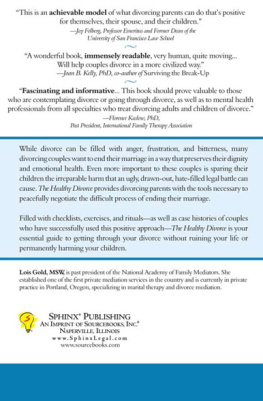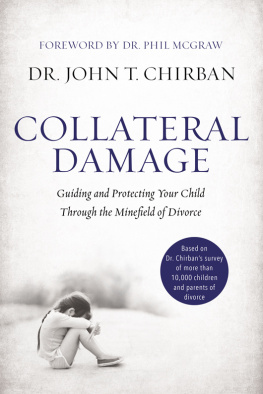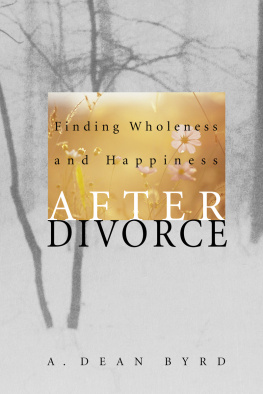TORN ASUNDER
Children, the Myth of the Good Divorce, and the Recovery of Origins
EDITED BY MARGARET HARPER McCARTHY

WILLIAM B. EERDMANS PUBLISHING COMPANY
GRAND RAPIDS, MICHIGAN
Wm. B. Eerdmans Publishing Co.
2140 Oak Industrial Drive NE, Grand Rapids, Michigan 49505
www.eerdmans.com
2017 Margaret Harper McCarthy
All rights reserved
Published 2017
23 2 1 0 19 18 171 3 4 5 6 7
ISBN 978-0-8028-7205-0
eISBN 978-1-4674-4534-4
Library of Congress Cataloging-in-Publication Data
Names: McCarthy, Margaret Harper, 1962 editor.
Title: Torn asunder: children, the myth of the good divorce, and the recovery of origins / edited by Margaret Harper McCarthy.
Description: Grand Rapids, Michigan: Eerdmans Publishing Company, 2016.
Identifiers: LCCN 2015045474 | ISBN 9780802872050 (pbk.: alk. paper)
Subjects: LCSH: Divorce. | DivorceReligious aspects. | Children of divorced parents. | Families.
Classification: LCC HQ814 .T67 2016 | DDC 306.89dc23
LC record available at http://lccn.loc.gov/2015045474
Humanum is an imprint of the John Paul II Institute for Studies on Marriage and Family at the Catholic University of America in Washington, D.C.
Contents
Richard P. Fitzgibbons, MD, psychiatrist, Institute for Marital Healing.
Elizabeth Kantor, author of The Jane Austen Guide to Happily Ever After.
Margaret R. Laracy, PsyD, adjunct assistant professor of psychology, John Paul II Institute for Studies on Marriage and Family at The Catholic University of America.
Lisa Lickona, Editor for Saints for the Magnificat.
Antonio Lpez, FSCB, provost and dean, John Paul II Institute for Studies on Marriage and Family at The Catholic University of America.
Ryan C. MacPherson, chair of the History Department, Bethany Lutheran College.
Elizabeth Marquardt, author of Between Two Worlds: The Inner Lives of Children of Divorce.
Margaret Harper McCarthy, assistant professor of theological anthropology, John Paul II Institute for Studies on Marriage and Family at The Catholic University of America.
Andrew Root, Carrie Olson Baalson Associate Professor of Youth and Family Ministry, Luther Seminary.
Jeanne Heffernan Schindler, fellow of the Office for Cultural and Pastoral Outreach, John Paul II Institute for Studies on Marriage and Family at The Catholic University of America.
Nathan Schleuter, associate professor of philosophy, Hillsdale College.
Andrew J. Sodergren, MTS, PsyD, adjunct assistant professor of psychology, John Paul II Institute for Studies on Marriage and Family at The Catholic University of America.
Charles E. Stokes, affiliate scholar, Institute for American Values.
Paul Sullins, associate professor of sociology, The Catholic University of America.
Vicki Thorn, adjunct assistant professor of psychology, John Paul II Institute for Studies on Marriage and Family at The Catholic University of America.
Sr. M. Maximilia Um, FSGM, JCL, provincial superior, Sisters of St. Francis of the Martyr St. George.
Gintautas Vaitoska, director of the Studies of Marriage and the Family Program, International Theological Institute in Austria.
Amy Ziettlow, ordained minister, Evangelical Lutheran Church in America.
These days, it is clear to everyone that we are in the midst of a great debate over the nature of marriage, especially as concerns the subjects of it, whether they be a man and a woman whose love in principle is capable of generating children, or simply two individuals who love each other. At first glance, the questioning about what marriage is seems entirely new. In one obvious way, of course, it is, since no one in all of recorded history has ever suggested that amorous friendships among men or among women however much these might have been celebrated or tolerated might qualify as material for marriage. In another way, however, it is not new at all, since the weakening of the once indissoluble link between marriage and children has been well underway for some time now.
Marriage, indeed, has for some time now has been a companionate Marriage of necessity has been subordinated to the sacred rights and goals of these individuals, even, and, perhaps especially, for those who married only for love. Indeed, as Wendell Berry has noted, marriage was and is thus subordinated for the consenting adults still in it. They are, he says, divorced in marriage.
Marriage, in what is evidently its most popular version, is now on the one hand an intimate relationship involving (ideally) two successful careerists in the same bed, and on the other hand a sort of private political system in which rights and interests must be constantly asserted and defended. Marriage, in other words, has now taken the form of divorce: a prolonged and impassioned negotiation as to how things shall be divided. During their understandably temporary association, the married couple
Naturally if marriage had to be subordinated to the two consenting adults defending their rights and interests in their pursuit of happiness, so did their children.
If there is a debate, then, about the relation between children and marriage, it is one that is first rooted in a broader culture of divorce, which has made its choice for the consenting adults in these companionate marriages. For all of its apparent advantages, it is undeniable that no-fault divorce opened the gates to the widespread instability that now exists between parents and their children, introducing the latter, as it has, to a whole array of new relationships in their ever-changing step and blended families.
It is from within this larger framework that we turn to the question of the children of divorce in this book. The child speaks eloquently about what is or is not negotiable for its own welfare and very being, while being subjected to the many social experiments of our time. And in doing so, it also speaks about the union that brought it into being in the first place, even in the poverty of the childs experience. The fruit bears witness to the tree, as the old proverb says. By looking at the children of divorce, then, we are faced with momentous questions about childhood as well as marriage itself, the adults in it, the young people being prepared for it, and what it is they all most deeply desire. In sum we are faced with the central question about our humanity. The attention on the child in our case, then, is not a retreat from all of the publically censored questions concerning the nature of marriage, of love and happiness, and the human person. It is, rather, a way of focusing these, whether they be dismissed from public discourse or not.
There are of course, many who have studied the unsettling effects of divorce on children.in this work who now as adults have begun to speak about the effects of divorce. It is one thing to be the object of social research. It is quite another, though, to speak about divorce from the inside. The freshness, moreover, is precisely what these adults say about what is ultimately at stake for those caught up in it, both children and parents.
What these new interlocutors in the debate about divorce have begun to identify in themselves is a wound that affects them at the level of their very being. In her groundbreaking book, Elizabeth Marquardt speaks about being caught










